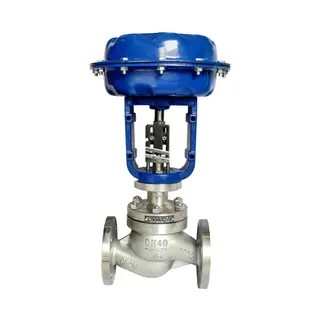Introduction
In the fast-paced world of industrial automation and fluid management, achieving precision, reliability, and efficiency is key to optimizing system performance. Among the critical components enabling such control is the pneumatic single-seated control valve—a robust solution engineered for accurate flow regulation, minimal leakage, and reliable operation across a wide range of demanding applications.
This article offers a comprehensive overview of pneumatic single-seated control valves, including their working principles, advantages, key performance attributes, and industry-specific applications. Whether you're an engineer, plant operator, or procurement specialist, understanding this valve type will help ensure optimal selection and integration into your control systems.
What Is a Pneumatic Single-Seated China Control Valve?
A single-seated control valve is a linear motion valve featuring a single plug and a single seat. Designed for precise modulation and tight shutoff, it is ideally suited for applications where accuracy, minimal leakage, and quick response are essential.
Unlike double-seated designs, the single-seat structure offers fewer leak paths and better sealing. Its top-guided stem ensures stable movement of the valve plug, allowing for smooth, precise flow control. The internal flow path is typically engineered to reduce turbulence and pressure loss, resulting in better efficiency and flow capacity.
Why Choose Pneumatic Single-Seated Control Valves?
Equipped with a pneumatic actuator, these valves respond rapidly to control signals—usually 4–20 mA or a pneumatic pressure input—by positioning the valve plug in real-time. This makes them highly responsive and ideal for continuous process regulation.
Key Advantages:
- High Flow Accuracy: Complies with IEC 534-2-1976 standards
- Tight Shutoff: Meets ANSI B16.104 (Class IV or VI) leakage specifications
- Wide Temperature Compatibility: Operates in extreme thermal conditions
- Versatility: Handles gases, steam, slurries, and corrosive liquids
- Compact Design: Lightweight construction for easier installation and maintenance
Working Principle
The valve operates by translating pneumatic input into linear motion:
- A positioner receives a control signal from the automation system.
- The pneumatic actuator responds by adjusting air pressure to move a diaphragm or piston.
- This movement drives the valve stem, shifting the plug up or down.
- The plug’s position relative to the seat controls fluid flow precisely.
The S-shaped flow path in the valve body reduces resistance and noise while improving energy efficiency. The top-guided plug ensures stability and minimizes vibration and wear.
Applications Across Industries
Pneumatic single-seated control valves are deployed in a wide range of industries for their reliable modulation and sealing performance:
1. Oil & Gas
Used for regulating hydrocarbon flow, gas injection, vapor recovery, and pressure control under high-pressure and high-temperature conditions.
2. Chemical Processing
Ideal for precise dosing and handling of corrosive fluids, acids, and solvents. Resistant to chemical attack with appropriate material selections.
3. Power Generation
Controls steam, feedwater, and cooling water systems. Withstands extreme temperatures and pressures in boiler and turbine circuits.
4. Pharmaceutical Manufacturing
Supports sterile processing environments with tight shutoff and smooth internal surfaces to meet sanitary standards.
5. Food & Beverage
Used in CIP (clean-in-place) systems and fluid handling with hygienic design and zero-contamination operation.
Key Performance Features
1. Top-Guided Plug Design
Maintains plug alignment during stroke movement, enhancing durability and minimizing vibration or misalignment.
2. High Cv & Low Pressure Drop
The flow channel design improves flow coefficient by up to 30%, enabling higher capacity and smoother operation.
3. Compact Multi-Spring Actuator
Reduces overall valve height and weight by up to 30% compared to older models. Ideal for space-constrained or modular setups.
4. Shutoff Classes
- Metal-to-Metal Seats: Meet ANSI Class IV for moderate shutoff
- Soft Seats (e.g., PTFE): Achieve ANSI Class VI for zero-leak applications
5. Wide Rangeability
Offers a turndown ratio of 50:1, allowing fine control across wide flow variations without compromising stability.
6. Bellows Seal Option
Provides zero stem leakage, essential for fugitive emission control or hazardous fluid handling.
7. Insulation Jacket Option
Keeps media at operational temperature—prevents crystallization or solidification in critical processes.
Materials and Customization Options
Body Materials:
- WCB
- CF8 / CF8M (Stainless Steel)
- Alloy 20
- Hastelloy, Monel (for corrosive services)
Trim Options:
- Hardened stainless steel
- Stellite-coated components
- Soft seats (PTFE, EPDM, Viton) for tight sealing
Actuator Accessories:
- Electro-pneumatic positioners
- Limit switches and proximity sensors
- Air filter regulators
- Manual handwheels
These customization options enable seamless integration into both legacy and modern process control systems.
Maintenance and Lifecycle Benefits
The simplified structure of pneumatic single-seated control valves translates into easier servicing and lower operational costs:
- Fewer Parts = Fewer Failures
- Top-Entry Access for inline maintenance without valve removal
- Longer Life thanks to guided plug design reducing internal wear
- Lower TCO due to reduced maintenance needs and improved efficiency
Conclusion
The pneumatic single-seated control valve is a high-performance solution for precise, responsive, and reliable flow control across a broad spectrum of industries. Its compact, guided design ensures tight shutoff, wide control range, and operational resilience in even the most demanding environments.
By investing in a high-quality valve tailored to your process conditions—backed by proper material selection, accessories, and maintenance planning—you secure long-term reliability, minimize unplanned downtime, and achieve consistent product quality.
Whether you’re managing hydrocarbons, chemicals, steam, or sensitive pharmaceutical fluids, the pneumatic single-seated control valve is a smart choice for efficient and safe process control. Know more about Google SEO Directory





Comments